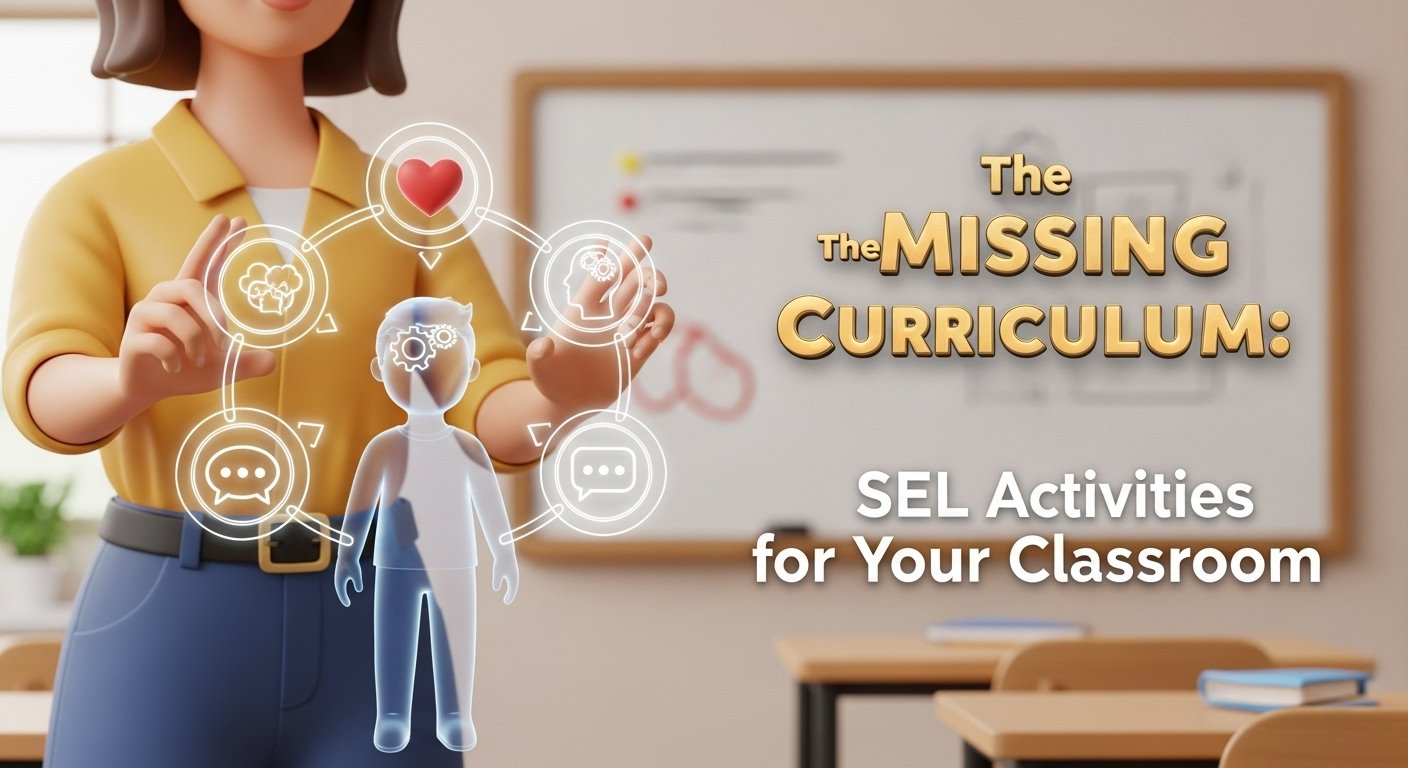The Missing Curriculum: How 5-Minute Social-Emotional learning Activities Can Transform Your Classroom
We’ve all been there. It’s the middle of a lesson you’ve spent hours preparing. You’re explaining a key concept when you see it: a student in the back, head down, completely shut off. It’s not defiance; it’s despair. They made a small mistake, felt a wave of frustration, and now, their brain has hit the eject button on learning for the rest of the period. In that moment, it doesn’t matter how brilliant your lesson is. The student’s emotional state has built a wall that no academic content can penetrate. This is the daily reality in our classrooms, and it’s why the most important subject we can teach might not be on the official curriculum. It’s social-emotional learning.
As educators in 2025, we are keenly aware that our students are coming to us with more stress, anxiety, and distraction than ever before. The old model of simply managing behavior is no longer enough. We have to actively teach the skills of emotional regulation, resilience, and empathy. The good news? This doesn’t require a massive curriculum overhaul or hours of extra planning. Powerful social-emotional learning can be woven into the fabric of your day through short, intentional, and transformative activities. This is your practical playbook for building a more resilient, empathetic, and engaged classroom, one 5-minute activity at a time.
More Than a Buzzword: SEL is the Foundation, Not the Frills
Let’s address the elephant in the room: teachers are stretched thinner than ever. When you’re juggling lesson plans, grading, and a dozen other responsibilities, social-emotional learning can feel like “one more thing” to add to an already overflowing plate.
But what if we reframed it? What if SEL isn’t the dessert, but the plate itself? What if it’s the foundational skill set that makes all other learning possible?
Neuroscience confirms what great teachers have always known: a stressed, anxious, or dysregulated brain cannot learn effectively. When students are in a state of fight, flight, or freeze, the learning centers of their brain literally go offline. Social-emotional learning is the practice of teaching students how to notice and manage these internal states. It’s the prerequisite for academic success. The leading framework for this work, developed by the Collaborative for Academic, Social, and Emotional Learning (CASEL), gives us a clear roadmap with its five core competencies: Self-Awareness, Self-Management, Social Awareness, Relationship Skills, and Responsible Decision-Making.
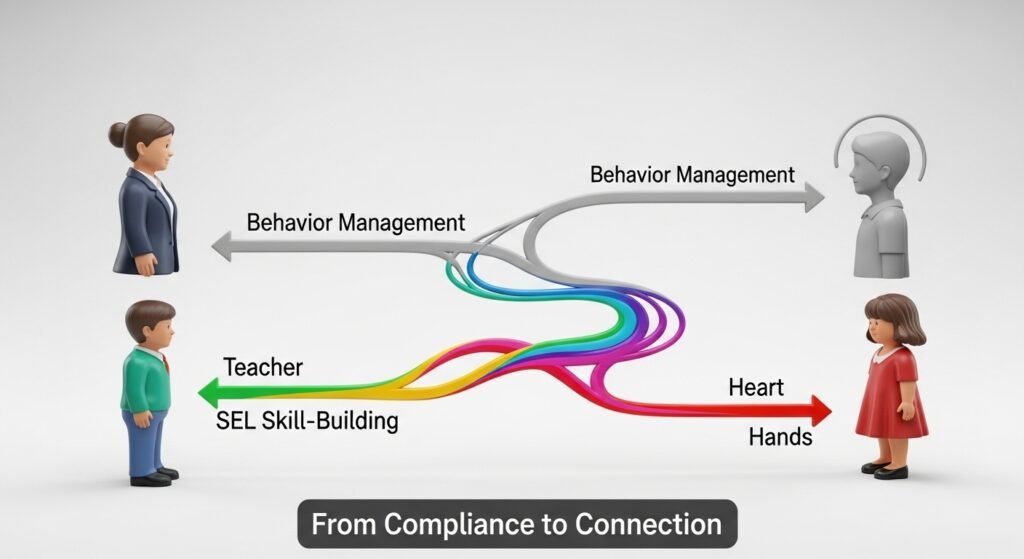
The Shift from “Managing Behavior” to “Teaching Skills”
The core philosophical shift of SEL is moving from a reactive to a proactive approach. We stop asking, “How can I get this student to comply?” and start asking, “What skill is this student missing, and how can I teach it to them?”
| Behavior Management (Reactive) | SEL Skill-Building (Proactive) |
| Focus: Compliance and control. | Focus: Competence and connection. |
| Teacher’s Question: “Why are you doing that?” | Teacher’s Question: “I notice you’re feeling frustrated. What’s a strategy we can use?” |
| Goal: Stop the unwanted behavior. | Goal: Teach the desired skill (e.g., emotional regulation, conflict resolution). |
| Tools: Rewards, consequences, punishment. | Tools: Check-ins, modeling, practice, reflection. |
| Outcome: A quiet, compliant classroom (often temporary). | Outcome: A resilient, collaborative community (long-term). |
Export to Sheets
This shift is profound. It reframes “misbehavior” as a teachable moment, transforming our classrooms into places where students don’t just learn math and reading, but also learn how to be capable, caring human beings.
Top Mental Health Resources for College Students
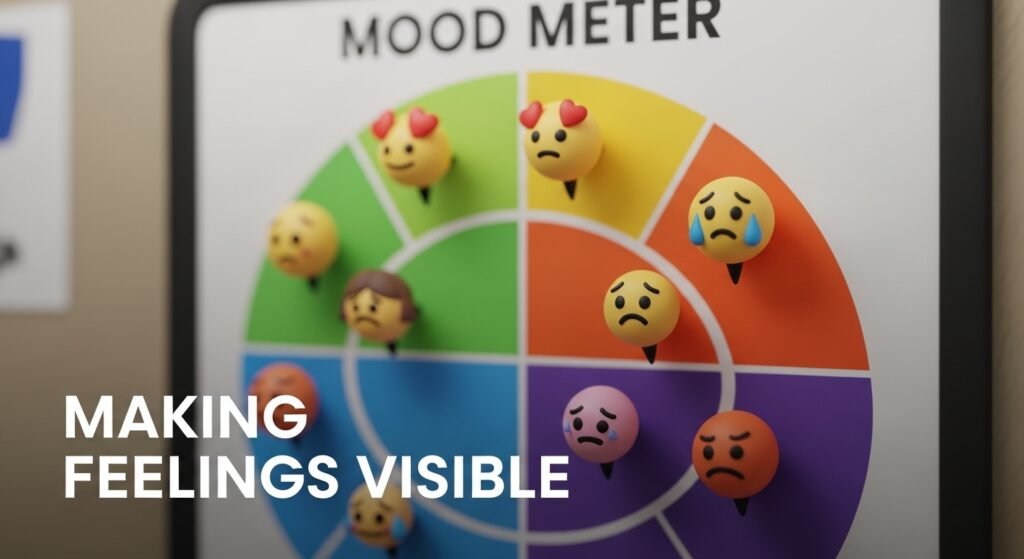
The Teacher’s Playbook: 10 Simple SEL Activities for Your Classroom
Here are practical, low-prep activities organized by the CASEL 5 competencies. Many of these can be done in just a few minutes as a warm-up, a brain break, or a closing circle.
Pillar 1: Self-Awareness (Knowing Yourself) 🧠
This is the foundation—the ability to recognize one’s own emotions, thoughts, and values.
- Activity 1: The “Emotional Check-In” (2 minutes): Start your class or a transition by asking students to check in with their feelings. This can be as simple as having them hold up a number of fingers from 1 (terrible) to 5 (fantastic). This normalizes talking about feelings and gives you a quick read of the room.
- Activity 2: The “Mood Meter” (3 minutes): Based on the work at the Yale Center for Emotional Intelligence, the Mood Meter is a quadrant with four colors representing different feeling states (e.g., red for high energy/unpleasant, yellow for high energy/pleasant). Have students place a sticky note or simply point to where they are on the meter. It gives them a more nuanced vocabulary for their emotions beyond “mad” or “sad.”
Pillar 2: Self-Management (Controlling Yourself) 🧘
This is the ability to regulate one’s emotions, thoughts, and behaviors effectively in different situations.
- Activity 1: “Mindful Minutes” (1 minute): When you notice the class energy is getting chaotic or sluggish, pause for a mindful minute. Guide students through a simple breathing exercise (like “box breathing”—inhale for 4, hold for 4, exhale for 4, hold for 4) or have them just sit in silence and notice the sounds around them. It’s a powerful reset button for the nervous system.
- Activity 2: “Goal-Setting Sprints” (3 minutes): At the start of an independent work period, have students set a small, achievable “micro-goal” on a sticky note. It could be “I will finish three math problems without getting distracted” or “I will write one strong topic sentence.” This builds the skill of focused effort and self-discipline.
Pillar 3: Social Awareness (Understanding Others) 👀
This is the ability to take the perspective of and empathize with others.
- Activity 1: “Appreciation, Apology, Aha!” (5 minutes): This is a fantastic closing circle activity. Go around the circle and give students a chance to share one of three things: an appreciation for a classmate, an apology for something that happened, or an “aha!” moment they had during the day. It builds community and encourages reflection.
- Activity 2: “What’s Their Perspective?” (5 minutes): When reading a story or discussing a historical event, pause and ask students to step into the shoes of a character. “What might this character be feeling right now? What is their side of the story?” This simple practice builds the cognitive muscle of empathy.
AI SAT Prep Guide: Success Strategies 2025
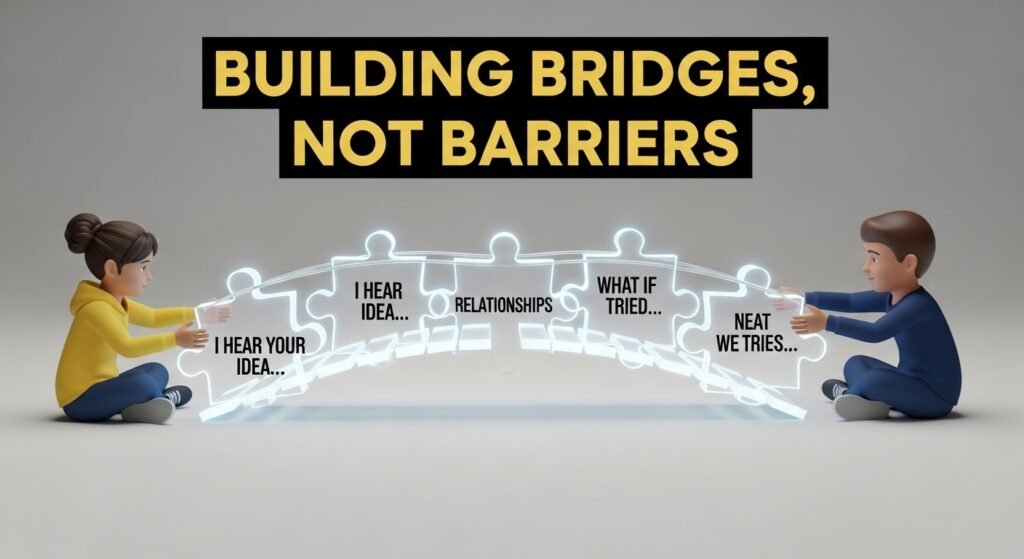
Pillar 4: Relationship Skills (Getting Along) 🤝
This is the ability to establish and maintain healthy and rewarding relationships with diverse individuals and groups.
- Activity 1: “Accountable Talk Stems” (Ongoing): Create a poster in your classroom with sentence starters for respectful dialogue. Things like:
- “I respectfully disagree with _______ because…”
- “Could you say more about what you mean by _______?”
- “I’d like to build on _______’s idea.” Actively model and encourage the use of these stems. It teaches students how to disagree without being disagreeable.
- Activity 2: “Low-Stakes Collaboration” (10 minutes): Give student groups a fun, low-stakes problem to solve, like a brain teaser or a building challenge with limited supplies. The primary goal isn’t solving the puzzle; it’s practicing communication, compromise, and teamwork.
Pillar 5: Responsible Decision-Making (Making Good Choices) 🤔
This is the ability to make caring and constructive choices about personal behavior and social interactions.
- Activity 1: The “Ripple Effect” Map (5 minutes): When a classroom issue arises (e.g., a conflict at recess), have students brainstorm the “ripple effect” of different choices. If one student shoves another, what are the ripples? (The person gets hurt, feelings are hurt, others feel unsafe, the teacher has to stop the lesson). This helps students see that their choices don’t happen in a vacuum.
- Activity 2: “Classroom Constitution” (Ongoing): At the beginning of the year, have the students themselves brainstorm and agree upon the rules and expectations for the classroom. When students have ownership over the rules, they are far more likely to follow them. This is a powerful exercise in collective, responsible decision-making.
A Personal Story: The Day a Check-In Changed Everything
I used to have a student, let’s call him Alex, who was a classic “disruptor.” He would constantly tap his pen, call out, and get out of his seat. My initial approach was purely behavioral: reminders, consequences, moving his seat. Nothing worked.
One morning, feeling frustrated, I decided to try a simple “Emotional Check-in.” As I went around the room, Alex quietly held up one finger: “terrible.” Later, I pulled him aside and asked what was going on. He told me his family had just moved and his dog had run away the night before. He wasn’t trying to be “bad”; his little body was just buzzing with anxiety and grief, and it was coming out as disruptive behavior. In that moment, my entire perspective shifted. The problem wasn’t his behavior; it was his heartbreak. We made a plan for him to take breaks when he felt overwhelmed, and I connected his family with the school counselor. The disruptions didn’t vanish overnight, but they decreased dramatically. A two-minute social-emotional learning activity gave me the data I needed to finally teach the whole child, not just manage his behavior.
AI SAT Prep Guide: Success Strategies 2025
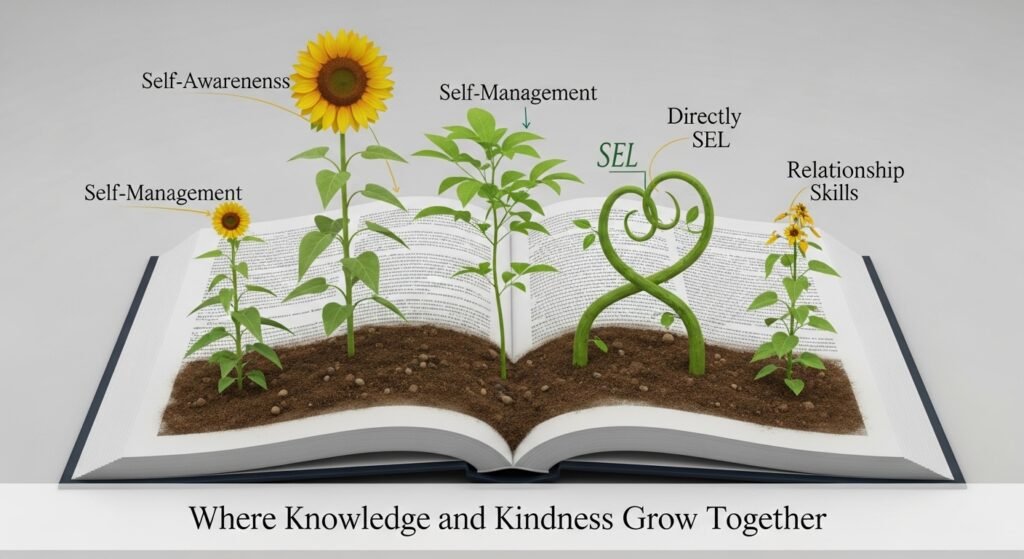
Weaving SEL into Your Academic Fabric
The most effective social-emotional learning is not a separate, 30-minute block. It’s seamlessly integrated into the academic work you’re already doing.
- In English: Analyze a character’s self-awareness (or lack thereof). Use perspective-taking to understand the motivations of the antagonist.
- In History: Discuss the social awareness and relationship skills (or failures) that led to major historical events.
- In Science: Use collaborative skills during lab experiments. Practice self-management and resilience when an experiment fails.
- In Math: Teach students to manage frustration and set micro-goals when tackling a difficult multi-step problem.
When you start looking for them, you’ll see that opportunities for social-emotional learning are everywhere.
Conclusion: An Investment in Your Classroom and Their Future
Integrating these small social-emotional learning activities into your daily routine is not just one more thing on your to-do list; it’s an investment. It’s an investment in a calmer, more focused classroom culture. It’s an investment in fewer behavioral disruptions and more time for academic learning. And most importantly, it’s an investment in equipping your students with the essential life skills they will need to navigate an increasingly complex world.
You are not just teaching subjects; you are shaping humans. And by intentionally teaching these skills, you are giving them the tools they need to be successful, not just in your classroom, but in life.
What is one simple SEL activity you have found to be successful in your classroom? Share your wisdom and experience in the comments below!

